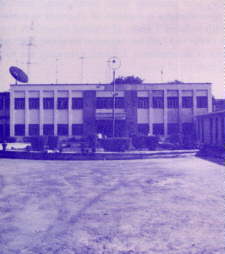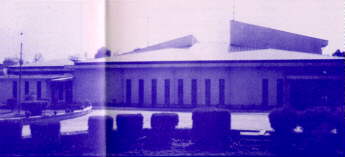



 Radio broadcasting is the cheapest and quickest means of
nmass communications in Nepal. In a mountainous country like
Nepal, radio broadcasting has proved a very effevtive medium
in disseminating information, educating people and entertaining
the masses. It has been providing various programmes aimed
at creating mass awareness. The people in the hilly areas and
many of the remote villages have no access to motorable roads
nor to any communication and entertainment facilities.
Illiteracy being a common feature among the people, little use
is made of the newspaper, which have very limited and delayed
circulations. Therefore, Radio has been most suitable means of
disseminating information and providing entertainment to the
masses in Nepal.
Radio broadcasting is the cheapest and quickest means of
nmass communications in Nepal. In a mountainous country like
Nepal, radio broadcasting has proved a very effevtive medium
in disseminating information, educating people and entertaining
the masses. It has been providing various programmes aimed
at creating mass awareness. The people in the hilly areas and
many of the remote villages have no access to motorable roads
nor to any communication and entertainment facilities.
Illiteracy being a common feature among the people, little use
is made of the newspaper, which have very limited and delayed
circulations. Therefore, Radio has been most suitable means of
disseminating information and providing entertainment to the
masses in Nepal.
(a) Short Wave: Three transmitters of 100 kw each enable transmissions on two frequencies
simultaneouslu.
(b) Medium Wave: There are transmitters of various capacities in all
the five development regions.
(i) Eastern Development Region: Theres is a stydio in Dhankuta
and a 100 kw transmitting station in Dharan with 10 kw standby
transmitter.
(ii) Central Development Region:
A 10 kw with 10 kw standby transmitting station in Bardibas. There is no
studio facility.
(iii) Western Development Region:
A 100 kw with 10 kw standby transmitting station and a studio in Pokhara.
(iv) Mid Western Development Region:
A 100 kw with 10 kw standby transmitting and studio in Surkhet.
(v) Far western Development Region:
A 10 kw with 10 kw stanby transmitting station and a studio in Dipayal.
Transmission Coverage
(a) The short wave transmission of Radio Nepal is estimated to reach listeners throughout the Kingdom.
(b) Medium Wave transmission covers 80% to 90% of the population.
Programming
(a) Regional Programming: Two hours of programmes for
audiences in different regions broadcast for audiences in different
regions broadcast from Regional stations simultaneously from 09:30
to 11:00 and 18:05 - 18:30 everyday.
(b) National Programmes: Broadcast for a duration of about 13 hours
everyday and 17 hours on public holidays from 06:00 hrs to 23:00
hrs.
Radio Nepal uses a wide range of formats including features,
documentaries, docu-dramas, dramas, talk shows, interviews, music
shows, live commentaries etc. Recognizing the citizen's rights to be
informed under a multi-party democracy. Radio Nepal attempts to
provide informative, educational as well as entertainment oriented
programmes. The major programme highlights include:
(a) EDUCATIONAL:
Programmes on religion, literatures, science and technology,
agriculture, women, health and sanitation, public health, children and
youth.
(b) ENTERTAINMENT:
(i) Music: Nepali songs, western music, Hindi songs and Ghazals,
(ii) Songs on Regional languages
(iii) Radio Dramas.
(c) INFORMATION:
(i) News and Current Afairs
(ii) Phone-in for Parliamentarians
(iii) Radio Reports.
Programmes on information and education constitutes 40% of the
total programming and entertainment covers 60% which also includes
commercials.
Radio Nepal has sufficient studios for programme production, music recording, talk shows and news broadcasts. A music library at its premises in Singha Durbar has a collection of about 15,000 songs. Foreign broadcasting Stations also make use of our Studio facilities for live broadcasts on a rental basis.
COMMERCIAL TIMING SCHEDULE OF
NATIONAL TRANSMISSION
a) Super time - 7:45 a.m. to 1:30 p.m. Saturday
b) 'A' time - 7:45 a.m. to 9:00 a.m. Sunday to Friday
c) 'B' time - 9:30 a.m. to 11:00 a.m. Sunday to Friday
- 8:15 p.m. to 11:00 p.m. Sunday to Saturday
d) 'C' time - 2:00 p.m. to 3:00 p.m.
- 10:05 p.m. to 10:55 p.m. Saturday to Sunday
Station | Medium Wave KHz | Short Wave MHz Summer broadcast | F.M. MHz |
Kathmandu | 792 | 7.165 (41 mb) | 100 |
Bardibas | 1143 | 5.005 (60 mb) |
|
Dhankuta / Dharan | 648 | Winter broadcast 5.005 (60 mb) |
|
Pokhara | 684 | 3,230 (90 mb) |
|
Surkhet | 576 |
|
|
Dipayal | 810 |
|
|
From old modest beginning 46 years ago, Radio Nepal has expanded considerably over the years. With over 600 staff members in different dividions and the acquisition of equipment in tune with the technological innovations, Radio Nepal aims to emerge as the media for the millions in Nepal as well as across regional frontiers.
There are plans for a filling station at different parts of uncovered areas and a second channel in the existing premises in the near future.
RADIO BROADCASTING SERVICERadio NepalPh: 243569, 212950 Fax: 977-1-221952
Copyright 1997 Radio Nepal |

![]()
Webmaster: Anita Shrestha, Inc.